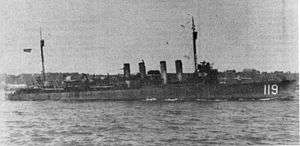USS Lamberton (DD-119)
 | |
| History | |
|---|---|
| Namesake: | Benjamin P. Lamberton |
| Builder: | Newport News Shipbuilding and Drydock Company |
| Laid down: | 1 October 1917 |
| Launched: | 30 March 1918 |
| Commissioned: | 22 August 1918 |
| Decommissioned: | 13 December 1946 |
| Reclassified: |
|
| Fate: | Sold, 9 May 1947, scrapped |
| General characteristics | |
| Class and type: | Wickes class destroyer |
| Displacement: | 1,090 tons |
| Length: | 314 ft 5 in (95.83 m) |
| Beam: | 31 ft 8 in (9.65 m) |
| Draft: | 8 ft 8 in (2.64 m) |
| Speed: | 35 knots (65 km/h) |
| Complement: | 113 officers and enlisted |
| Armament: | 4 × 4" (102 mm), 2 × 3" (76 mm), 1 dcp., 2 dct. |
USS Lamberton (DD-119)/(DMS-2) was a Wickes-class destroyer in the United States Navy. She was the only ship named for Benjamin P. Lamberton, an admiral who had served with Admiral Dewey in the Battle of Manila Bay.
Lamberton was laid down 1 October 1917 by Newport News Shipbuilding and Drydock Company, Newport News, Virginia; launched 30 March 1918; sponsored by Miss Isabell Stedman Lamberton, Admiral Lamberton's granddaughter; and commissioned 22 August 1918, Lieutenant Commander Frank Slingluff, Jr. in command.
Service history
After shakedown in the Caribbean, Lamberton joined the Atlantic Fleet for maneuvers off the Azores in the spring of 1919. Reassigned to the newly formed Pacific Fleet, the destroyer departed Hampton Roads 19 July and arrived at San Diego 7 August.
Based at San Diego, Lamberton operated along the west coast from August 1919 until June 1922. She participated in training maneuvers and performed experiments to develop superior naval tactics. The destroyer decommissioned at San Diego 30 June 1922.
World War II
Lamberton recommissioned 15 November 1930, Lieutenant Commander S. N. Moore in command. Operating along the west coast, she performed training exercises for nearly 2 years. She was reclassified AG-21 on 16 April 1932 and converted to a target-towing ship. From 1933 until 1940 she operated out of San Diego towing targets for surface ships, submarines, and aircraft, a role which paid dividends during World War II. She also engaged in experimental minesweeping exercises off the west coast and was reclassified DMS-2 on 19 November 1940. The actor Ernest Borgnine served aboard the Lamberton before the war, being discharged in September 1941. He reenlisted in January 1942 and served in the U.S. Navy with the Atlantic Fleet.[1]
After arriving Pearl Harbor 11 September 1941, Lamberton resumed target towing and ASW screening operations in the Hawaiian Islands. On 7 December 1941, she was escorting Minneapolis to Oahu when the Japanese struck at Pearl Harbor. Following the attack, she returned to port to sweep the harbor. For the next 7 months she remained on offshore patrol in the Hawaiian Islands.
Departing Pearl Harbor 11 July 1942, Lamberton steamed north; arriving at Kodiak, Alaska, 7 days later. The high-speed minesweeper performed patrol and escort duty in the frigid North Pacific during the Aleutian campaign. In mid-May 1943, she escorted the task group which brought reinforcements for the second landing at Massacre Bay, Attu. Lamberton continued patrol operations until late June when she sailed for Kuluk Bay.
The high-speed minesweeper then steamed to San Diego, arriving there 23 July. For the rest of the war, she performed target-towing operations off the west coast and out of Pearl Harbor.
Lamberton was reclassified AG-21 on 5 June 1945, and, following the Japanese surrender, she operated out of San Diego as an auxiliary.
She decommissioned at Bremerton, Washington, 13 December 1946 and was sold 9 May 1947 to National Metal and Steel Corporation, Terminal Island, Los Angeles, California for scrapping.
Awards
Lamberton received one battle star for World War II service.
See also
- List of World War II ships
- List of United States Navy destroyers
- List of ship launches in 1918
- List of ship commissionings in 1918
- List of ship decommissionings in 1946
Notes
- Citations
- ↑ Wise, p 118
- References cited
- This article incorporates text from the public domain Dictionary of American Naval Fighting Ships. The entry can be found here.
- Wise, Jr., James E. and Anne Collier Rehill (1997). Stars in Blue: Movie Actors in America's Sea Services. Naval Institute Press, Annapolis, Maryland. ISBN 978-1-55750-937-6.
